Never Stop Innovating: Gem Artist Chi Huynh
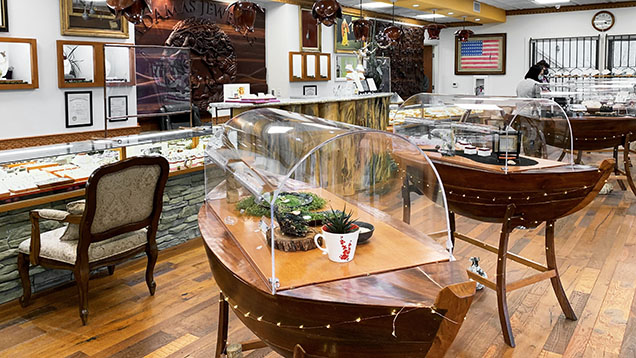
An elegant jewelry design enhances the beauty of a gemstone, transforming it into a wearable work of art. The designer behind Galatea: Jewelry by Artist seeks to bring the world’s beauty to life through art, innovation, science, and technology. Named for the ancient Greek myth of a beautiful statue that comes to life, Galatea was established in 1994 by Chi Huynh (figures 1 and 2). The story of Galatea reflects Huynh’s vision of expressing his creative ideas and innovation through jewelry. Using near field communication technology, jewelry from his Momento collection can store precious memories that are easily accessed with a smartphone. The Blossom collection uses ambient temperature changes to mimic the blooming of a flower. These and other groundbreaking works have earned Huynh numerous accolades in the industry. In early 2022, the authors had the opportunity to visit the store and workshop he co-owns and operates with his brother Kiet in San Dimas, California. During the visit, Huynh shared his experiences, inspirations, and passion for jewelry-making innovations.
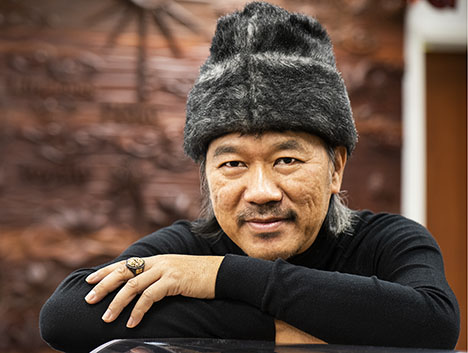
ENTERING THE JEWELRY BUSINESS
Chi Huynh, the youngest of eight (figure 3), was born in South Vietnam, where his father was a well-respected jeweler. As a child, he learned about jewelry making from his father and was tasked with making simple wedding bands until they were perfectly round. Huynh came to understand his father’s lesson: “If you want to be a good jeweler, it takes skill and repetition.”
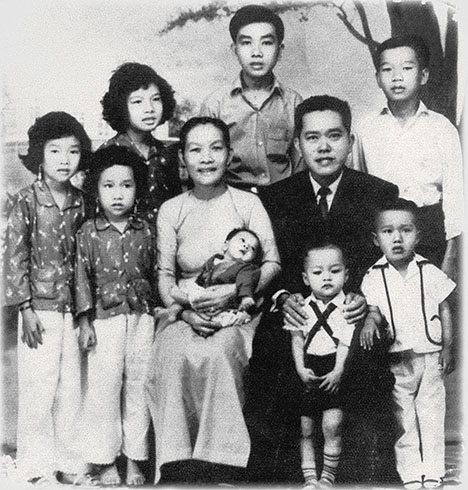

In 1980, when Huynh was 12 years old, his family fled in a small boat after the fall of South Vietnam. A violent storm left the boat drifting on the ocean for more than two weeks. After being robbed by pirates and nearly dying of hunger and thirst, they were rescued by a Thai fisherman, first reaching a refugee camp in Thailand and then Los Angeles (figure 4). Through this life-altering journey and near-death experience, Huynh realized the gift of life and vowed to bring beauty into the world. Today, he considers himself an artist who creates jewelry out of a sense of curiosity, inspired by the natural beauty of the universe.
Arriving in the United States without knowing any English, Huynh used drawing as a tool to express himself and interact with others. At a young age, he recognized visual arts as a universal language and means of communication. He explored different forms of art, including painting, sculpting, music, and poetry, seizing every opportunity to read and learn.
Huynh’s father eventually started a new jewelry business. But following his father’s path as a jeweler did not appeal to Huynh, who desired a more creative outlet. Nevertheless, in the early 1990s, he joined his father and brother at the JCK Show in Las Vegas to learn more about the industry. He noticed that most exhibitors carried similar jewelry styles, few of which intrigued him. This motivated him to create something different, and out of this Galatea was born in 1994. Inspired by the Greek myth, Galatea represents Huynh’s vision of creating jewelry that comes to life.
Lacking the funds to start a large-scale business, Huynh initially used his sculpting and carving talents to hand-carve wax models for other manufacturers. He loved the challenge and became a well-known carver in the industry. But when that challenge waned, he decided to make his own jewelry. To him, making jewelry meant more than just design sketches—it meant bringing new concepts to the industry.
MAJOR GEM AND JEWELRY INNOVATIONS
The authors were intrigued not only by Huynh’s beautiful jewelry collections on display at the Galatea workshop, but also by more than a dozen patents granted for his products. Asked what inspires his ideas, Huynh said, “Jewelry is like a painting. It enters the eyes, enters the mind, and then touches the heart. Therefore, it starts from what it means to you. Creativity is a process of expressing oneself or losing oneself in a process of living. If you want to truly see the world, you need to learn to see with the eyes of a child. See it without label and see it as what it is, so you can truly see it for itself through your own vision.”
Huynh has brought groundbreaking jewelry design concepts to the industry by expressing himself and applying various innovations. The following sections highlight some of Huynh’s products, which often combine several of his techniques into one piece of jewelry.
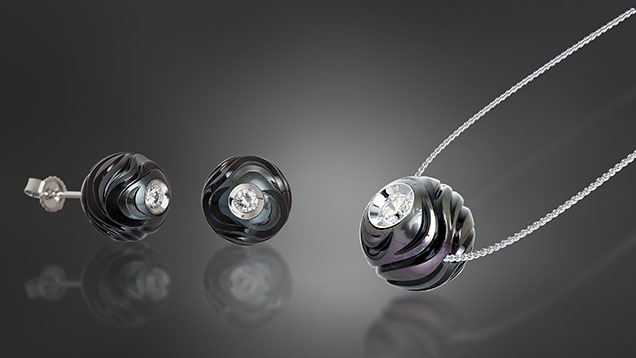
Diamond in a Pearl. The Diamond in a Pearl collection (figure 5) was Galatea’s first, created in 1999 as an expression of Huynh’s love for his wife. When a mollusk is irritated by a foreign object, such as a grain of sand, it secretes nacre, or mother-of-pearl, to surround the irritant, resulting in a beautiful pearl. In this design, the diamond represents the grain of sand, signifying pain or hardship in life, and the pearl surrounding it represents love that relieves the pain. This collection symbolizes how true love can endure and thrive to become something beautiful.
This design required extensive experimentation to find a way to avoid damaging the pearl while drilling a large hole to hold the precious metal mounting and the diamond. Huynh discovered he could achieve this goal with machinery and tools not commonly used by jewelers.
Carved Pearls. One of the most important considerations for pearl consumers is a smooth surface free of blemishes (Liddicoat, 1967). This is true for both natural and cultured pearls. While many believe that a pearl is carved to remove surface imperfections, that is not the case for Galatea. Huynh believes that no carving process can turn a low-quality pearl into a high-quality one. Instead, a carved pearl must start as a good-quality pearl. The carving gives the piece originality and individuality. (Due to the rarity of natural pearls, Huynh carves only cultured pearls of good quality.) The carved pearl technique was patented in 2006 (Huynh, 2006).
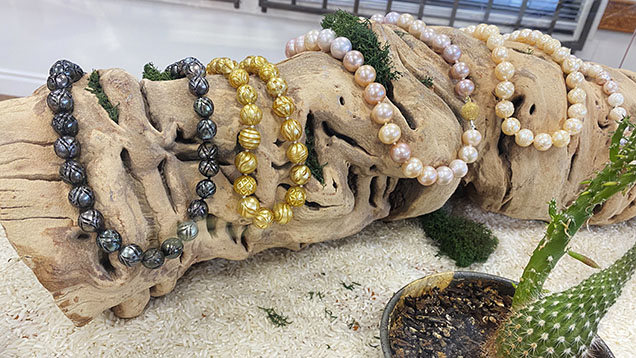

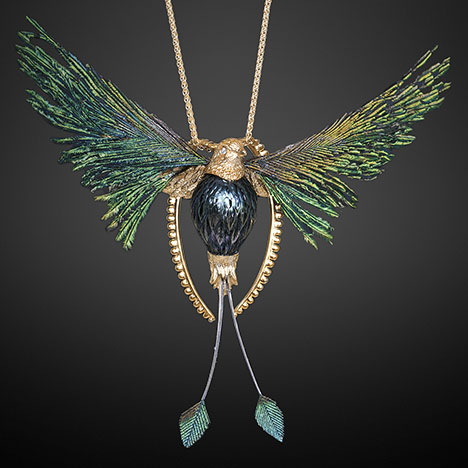
Huynh primarily uses Tahitian pearls for carving, as well as some South Sea and freshwater pearls, from round to baroque shapes (figures 6–8). Huynh considers baroque pearls especially pleasurable to work with, since their sizes and shapes allow more usable space for the carver’s imagination and combination with other techniques such as “druzy in a gem” (Huynh, 2018a, 2018b) (figure 7). Akoya pearls are not ideal given their small size and thin nacre, which is insufficient for all of the carving details.

Pearls with a nacre thickness of 1.0 to 1.5 mm are suitable for carving. With his pearl culturing and harvesting experience, Huynh has discovered that even if the bead nuclei were placed at the same time and the pearls were harvested together, the nacre thickness would vary considerably between the pearls. To choose pearls for carving, he drills a tiny hole to check the nacre condition and determine whether standard gemstone carving tools can be applied. Carving patterns are designed based on the theme of the jewelry and the pearl’s nacre thickness and surface appearance (figure 8). If carved pearls are to be combined in a bracelet or necklace, Huynh chooses pearls that will achieve a harmonious look (figure 9).
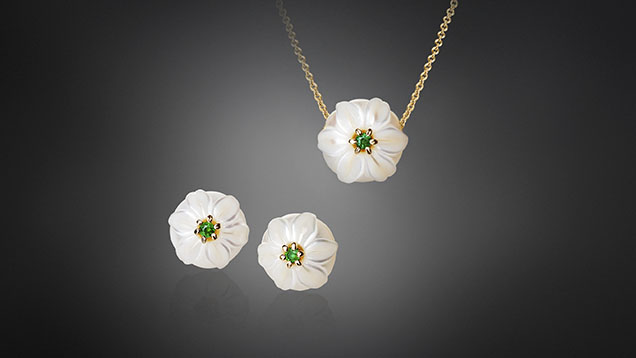
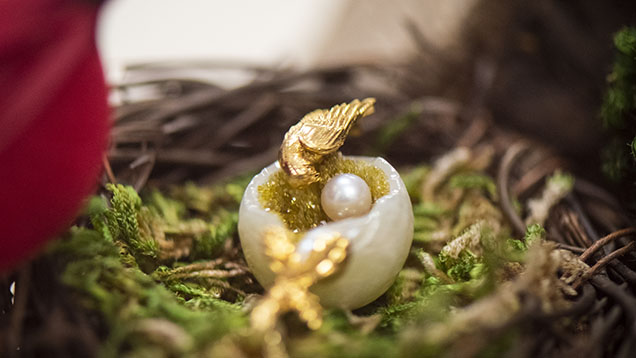
Carved pearls are incorporated in many other Galatea collections (figure 10). This design concept becomes even more intriguing when paired with gems and precious metals (figure 11). Carved pearls have unlimited uses, as they are created for wearers who don’t simply follow trends.
Galatea Pearls (Gem Bead Cultured Pearls). Galatea Pearls combine Huynh’s imaginative carving talent with the beauty of gemstones and pearls together. This idea was born when a pearl was accidentally damaged during the carving process, exposing a shell bead at the surface. Consequently, Huynh thought it would be interesting to experiment with using gemstones instead of mussel shells to trigger the growth of nacre, with the intent of revealing the gem’s beauty inside the carved pearl.
Carrying out this idea was no easy task. The pearl culturing process begins with the insertion of a suitable bead nucleus into a host mollusk. A biologically incompatible bead often results in bead ejection by the mollusk, difficult incision healing caused by too much gravitational force from the bead, or improper nacre deposition. Moreover, a bead nucleus must possess a thermal expansion coefficient equivalent to that of the pearl’s nacre, so that they expand to the same degree from the heat generated during drilling and carving. Otherwise, the pearl can crack or break apart.
Culturing pearls with gem materials that have different properties from the nacre posed an enormous challenge. However, Huynh remained determined, speaking with experienced pearl farmers and continuing to experiment with a variety of gem materials. The process required great patience over the course of thousands of implantations, and each batch of experiments took 18 months to two years to yield results.


Huynh’s experimentation revealed that black-lipped Pinctada margaritifera, the mollusk species that produces Tahitian pearls, yielded the highest-quality Galatea Pearls. This mollusk is large enough to accommodate beads about 8 mm in diameter while allowing enough nacre thickness to grow over the bead (figure 12). After years of effort, gem bead cultured pearls were successfully produced and patented internationally in 2004 and domestically in 2006 as Galatea Pearls (Huynh, 2004, 2006; figure 13). When harvested, the gem beads are entirely covered by dark nacre produced by the mollusk and will reveal a dramatic contrast after carving.
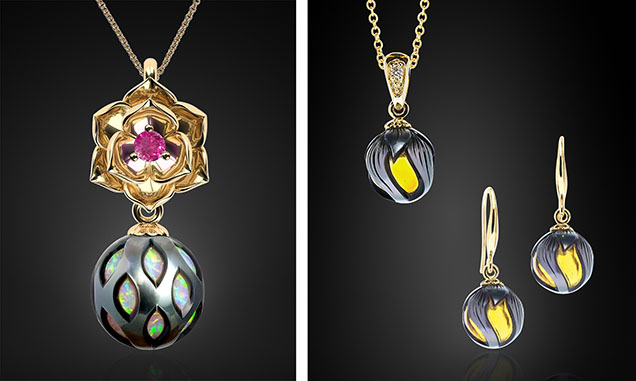

Beads used in Galatea Pearls include synthetic turquoise (made specifically for this process), red coral, and opal, as well as natural topaz, citrine, amethyst, amber, and other gems (figure 14). The technique can also be applied to the Pinctada maxima mollusk that produces South Sea pearl because the species and culturing technique are closely related to those of Tahitian pearls. The success of “Edison” pearls—near-round to round Chinese freshwater bead cultured pearls typically 10–14 mm in diameter, in orange, pink, and purple hues (Zhou et al., 2021)—offers an opportunity to apply the technique to freshwater cultured pearls as well. Galatea Pearls are also featured in other collections, such as Diamond in a Galatea Pearl (figure 15).
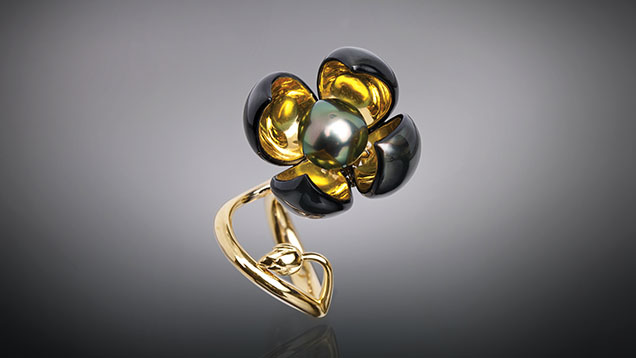

Two-Way Shape-Memory Jewelry. Shape-memory jewelry takes advantage of nitinol, a self-expanding titanium and nickel alloy commonly used in heart stents. During cardiac surgery, a stent is inserted to expand an artery or blood vessel and improve circulation (Ohkata, 2011). In medical use, the nitinol functions in one direction only, to expand in response to human body temperature. But this alloy can be “trained” to move two ways by bending the wire to the shape desired and then returning to its original shape. The repetition of this process allows the movement to be imprinted in the metal; the more training, the better the memory. The “memory” of the trained wire can be erased by heating it to about 750°F (400°C). The wires can then be used as is or embedded into other precious metals to make it move (figure 16). The Blossom collection features this innovation, patented in 2019 (Huynh, 2019), using trained nitinol wires coupled with small pearls as the petals of a flower surrounding a larger center pearl. The wire petals respond to heat to transform their shape. The flower gradually blossoms in warm temperatures and closes when it is cool, just as a living flower reacts to warm sunlight and cool nights (figures 16 and 17; see video above). Using a blow-dryer and a glass of cold water, Huynh demonstrated the Blossom ring’s function. The motion of the ring was carefully orchestrated and meticulously trained to bend to certain angles based on the size variation and arrangement of the smaller pearls and the placement of the ring on a finger. The use of nitinol wires makes each piece in the Blossom collection come to life.
Nitinol wires are durable, so it is not easy to break or distort them. But in the event they are accidentally distorted, applying heat using a cup of hot water or a blow-dryer will restore the wires to their original form.
Momento Jewelry. A pocket watch inherited from Huynh’s father inspired the Momento collection. For Huynh, the watch was not only a valuable accessory but also held memories of his father. Huynh pondered the idea of creating jewelry that could store memories to pass on to loved ones. He considered embedding a tiny computer chip into jewelry to store memories but realized that battery power would complicate construction and sustainability.
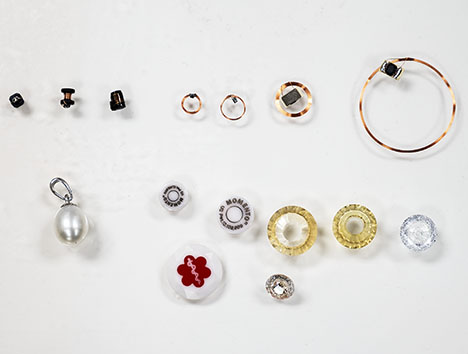
While collaborating on a wireless technology project with friends, Huynh became aware of near field communication (NFC) microchips, which use short-range electromagnetic radio technology. This technology allows two NFC-compatible devices to communicate or transfer data when they are physically touching or within approximately four centimeters of each other (Ortiz, 2008). An NFC microchip is able to store and transfer data but is a very small passive object that does not require a battery or an internal power source. An embedded NFC device is powered by an electromagnetic field between its antenna and another NFC antenna in the metal case of a digital device such as a mobile phone or tablet (Homkrajae, 2020; Lathiya and Wang, 2020) (figure 18). Similar in concept to the electric current created when a magnet passes through a metal coil, the electricity generated is just enough to power the device.

The main challenge in creating the Momento collection was the NFC device’s inability to operate when placed in a jewelry piece. The jewelry is a metal housing that acts as a Faraday cage, not allowing electricity to flow into the NFC device. But after extensive testing, Huynh overcame this obstacle and patented the product in 2014 (Huynh, 2018c) (figure 19). The product features a housing that hosts a “double-decker” structure. The gemstone is located in the upper deck and functions as the cover of the NFC chip, the antenna, and the surrounding bezel forming the lower deck. The bezel is highly electrically conductive and permits near field communication with the NFC chip.
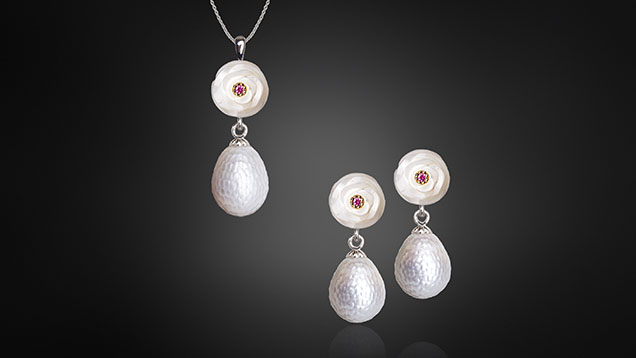

This NFC application has been used in nearly all Galatea designs, including carved pearls, Galatea Pearls, and shape-memory jewelry, adding an element of meaning to the finished pieces (figure 20). The Momento collection uses a Galatea mobile application to transmit data between the jewelry and the user’s mobile phone or tablet. The NFC chip can store a variety of digital assets, including images, audiobooks, songs, videos, health records, and more (figure 21). Special precautions are required when a Momento piece needs repair, as the NFC assembly can tolerate heat only up to 175°F (80°C), though only temperatures above 700°F (370°C) will destroy the chip.
Huynh sees each piece in the Momento collection as a digital keepsake and time capsule that can live on for generations. He continues to research new possibilities for NFC chips, including higher storage capacity.
DavinChi Cut. In addition to carving cultured pearls, Huynh excels in the art of gemstone cutting. The DavinChi collection was born out of Huynh’s curiosity about color and light as he considered the different colors that appear on the bottom surface of a DVD. He began to study the physics of light and learned how light travels and reacts with different media. The result was a special patented cut designed to make a gem refract its surroundings such as other gems, light, and images (Huynh, 2011). This creates the illusion of a gem changing colors when viewed from different angles. The name “DavinChi” was inspired by a statement in Leonardo da Vinci’s notebooks: “Be a mirror, absorb everything around you and still remain the same.”


At first glance, a DavinChi Cut gem appears to be upside-down (figure 22). Yet the stone is carefully designed. Each facet angle is precisely calculated to establish the right focal point to ensure that an object behind the stone is refracted by every facet. This is clearly visible when one draws a letter on a piece of paper and places the DavinChi Cut stone on top of the letter. The letter is refracted by every facet on the gem (figure 23). Faceting a DavinChi Cut stone requires great lapidary skill.

Although the DavinChi Cut works with most types of gemstones, the cut stone must not cancel the colors of the smaller gems placed behind it. Therefore, light-colored or colorless stones work best for the DavinChi Cut. The distance between the DavinChi Cut stone and the smaller gems is also important. The viewer must look at the whole construction from above to see the illusion of color change (figure 24).
ALL-AROUND ARTIST
Before he started making jewelry, Huynh was a woodcarver and painter, and today many of these works decorate his store and studio (figure 25). He also enjoys writing poetry and making music. “The Secret of Life Is in the Seed,” which received a 2018 JCK Jewelers’ Choice Award, unites several of Huynh’s artistic talents (figure 26). The center of the piece features a beautiful drop-shaped Tahitian pearl as the fruit. The pearl was partially carved open and mounted with red tourmalines, representing the seeds. Above the fruit is a small branch with green leaves and a pinkish red flower. Both were hand-painted with lacquer rather than enameled. Below the seed is a drop-shaped citrine representing the morning dew. Curiosity about his surroundings motivates and inspires Huynh to keep inventing new concepts and creating other artistic forms of expression.
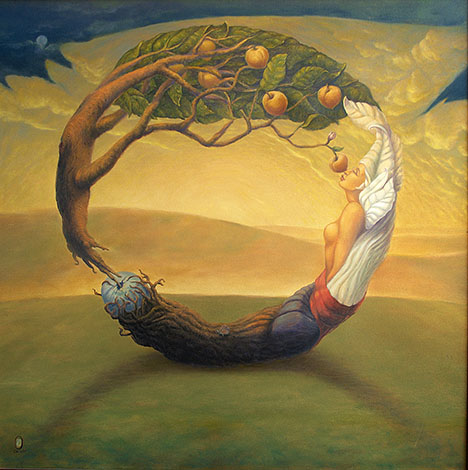

THE FUTURE OF GALATEA
Experimentation continues on the Momento collection and other shape-memory jewelry. In 2022, the authors saw newly developed men’s jewelry collections incorporating Huynh’s supreme carving skills (figure 27) and NFC chips, as well as other small gadgets used in jewelry pieces such as magnet-linked and stationed-pearl bracelets and necklaces.
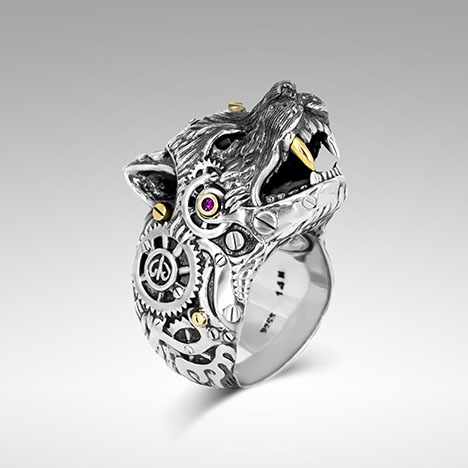
Since his first day as a jeweler, Chi Huynh has kept bringing new concepts, techniques, and products to the industry. Huynh’s wisdom, curiosity, and passion have built Galatea’s reputation in the jewelry market and garnered several design awards. As consumers seek originality and individuality through innovative, one-of-a-kind jewelry, his techniques and patents will continue to influence the market, opening doors for future generations of gem artists.



